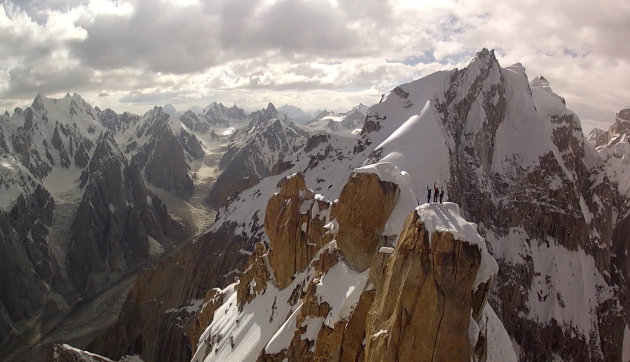By REBECCA SANTANA | Associated PressThe use of drones in Pakistan normally brings to mind images of U.S. spy planes attacking tribal areas. But drones now are being used to capture a different kind of picture in the country — showing some of the world's highest mountains being scaled by world-class climbers through some of Earth's thinnest air. Drones, or remote-controlled aircraft, have long been the domain of the American military and are used extensively in Pakistan's tribal areas near the Afghanistan border to spy on and target militants. Recently, however, civilians have increasingly turned to drones to shoot ground-breaking footage of adventure sports. This summer a Swiss expedition used remote-controlled helicopters to shoot rare footage of climbers on the Karakoram, one of the world's most demanding and formidable mountain ranges. "People are going to see footage from the Karakoram that no human being has ever seen," said Corey Rich, a photographer and videographer from Lake Tahoe, California, who was on the expedition. The expedition was a joint project between outdoor clothing and equipment company Mammut, and Dedicam, a firm that specializes in using remote-controlled helicopters to shoot video. Their goal: to document world-class mountaineer David Lama and his climbing partner Peter Ortner as they climbed Trango Tower. The sheer granite tower in the Baltoro Glacier is more than 6,000 meters (19,685 feet) above sea level and is one of the most technically difficult climbs in the world. Filmmakers long have used helicopters to capture aerial footage of climbers — as well as other extreme sport athletes like surfers and skiers —that is hard to capture from the ground. But helicopters are costly and can be dangerous if they crash or get too close to the people on the ground. Additionally, their beating rotors often kick up dust, snow and wind — and can push climbers off balance. Drones, which can weigh just a few kilograms (pounds) and cost between $1,000 and $40,000, are a fraction of the size and cost of the helicopters traditionally used in adventure photography. Newer models tend to have all of their rotors facing into the sky, making them look a bit like a mechanical flying spider or insect. The main concern for the summertime expedition was how — and if — the drone would perform in Pakistan's rugged conditions and high altitude. "The main challenge was that the air is much thinner, and we didn't know how the flight controls would work with this and the propellers and motors," said drone operator Remo Masima, from Lucerne, Switzerland. He brought two on the Pakistan expedition — one with four propellers and another with six. From the ground, he flew them with a handheld console that resembles a video game console, and wore goggles to let him see the camera's view. Another challenge was to find the climbers on the mountain. Tracing the planned trek route, Masima directed the drone up the mountain until he spotted them — more than a mile (roughly 2,000 meters) away. The result was stunning images of the Karakoram and the climbers making it to the top. Experienced climbers say the Karakoram puts the rest of the world's mountain ranges to shame. Neighboring Nepal has Everest, the tallest mountain in the world, but Pakistan has four of the world's 14 peaks that soar to more than 8,000 meters (26,246 feet) above sea level, including the second highest mountain on earth, K-2. Lama and Ortner said climbing the legendary Pakistan mountains was an amazing experience. "Here there are so many mountains, and so many difficult mountains, and mountains that haven't been climbed," said Lama. "That's probably why the Karakoram is known as paradise for us." This year has been particularly successful for Pakistan's climbing industry, which plummeted in the wake of the Sept. 11, 2001 terror attacks in the U.S. In addition to hosting the renowned Lama for the first time, Nazir Sabir, Pakistan's elder statesman of climbing who was the country's first person to scale Everest, said 30 climbers summited K-2 in 2012, the first summits from the Pakistani side of the mountain since 11 people died trying in 2008. And the drone footage obtained during Lama and Ortner's climb will expose even more viewers to the legendary Karakoram mountain range. Drones also increasingly are being used in other adventure sports to push conventional photography boundaries. Cameras on drones have been used to capture video of surfers on Hawaii's North Shore and to chase mountain bikers speeding down mountain trails. "I've filmed anything from kayaking, rock climbing, mountain biking, to track and field to just casual walking," said photographer and videographer Mike Hagadorn, who has begun to build his own drones to support his Colorado-based firm, Cloud Level Media. "Anything you can dream of — and as long as you don't crash — you can make it happen." Experts predict drone cameras eventually will become an integral part of every sports shoot. But for now, they're definitely a novelty. The Swiss team filming Lama said villagers in Pakistan stood in awe, staring at the drones as they buzzed around, whenever he used one on the expedition. "We were trying to do this shot that showed this quaint village," Rich said. "But every single person in the shot is standing, stopped in the street, looking up at the helicopter."
M WAQAR..... "A man's ethical behavior should be based effectually on sympathy, education, and social ties; no religious basis is necessary.Man would indeed be in a poor way if he had to be restrained by fear of punishment and hope of reward after death." --Albert Einstein !!! NEWS,ARTICLES,EDITORIALS,MUSIC... Ze chi pe mayeen yum da agha pukhtunistan de.....(Liberal,Progressive,Secular World.)''Secularism is not against religion; it is the message of humanity.'' تل ده وی پثتونستآن
Saturday, September 22, 2012
Drones capture mountain scenery in Pakistan
Subscribe to:
Post Comments (Atom)

No comments:
Post a Comment